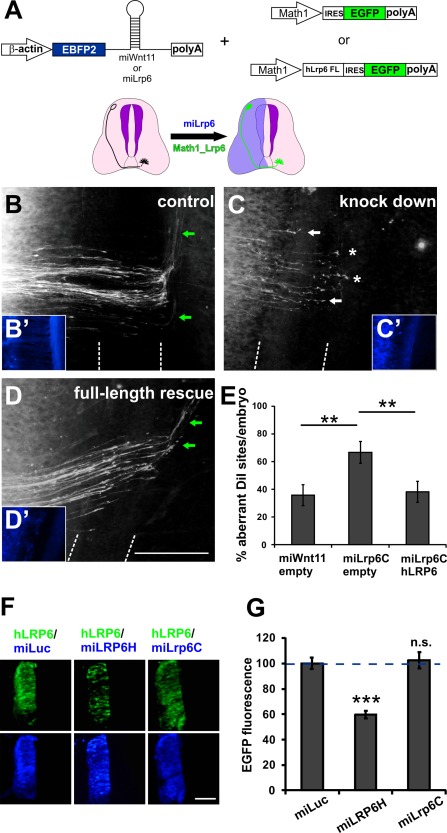Figure 9.

Lrp6 is required cell‐autonomously in dI1 commissural neurons. (A) Schematic drawings of miRNA and rescue constructs. Electroporation of miLrp6C reduces endogenous Lrp6 expression in one half of the spinal cord (blue, left side in the scheme). Specific expression of human LRP6 in dI1 neurons was achieved by electroporation of human LRP6 under the control of the Math1 enhancer. Injection and electroporation of miWnt11 was used as control (B) with pathfinding errors seen at 35.7 ± 7.5% of the DiI injection sites (E; N = 11; n = 75). Expression of the miLrp6C construct to reduce endogenous Lrp6 induced axon guidance defects at 66.6 ± 7.8% of the injection sites (C,E; N = 8; n = 52). Axon guidance was rescued by expression of human LRP6 specifically in commissural neurons (D,E; N = 13; n = 90), as aberrant axon guidance was only observed at 38.8 ± 6.8% of the DiI injection sites. Human LRP6 is not targeted by miLrp6C designed against chicken Lrp6 (F,G). The ratio between the green fluorescence derived from the construct encoding human LRP6 and the blue fluorescence derived from the miRNA construct containing either miLuc or miLrp6C was used for quantification. The ratio between hLRP6 and miLuc was set to 100% (100.0 ± 4.4%). A miRNA designed against human LRP6 efficiently downregulates hLRP6 (59.5 ± 3.0%), but miLrp6C designed against chicken Lrp6 does not reduce hLRP6 (102.5 ± 6.2%). A total of 30 sections (from 5 embryos; 6 sections per embryo) per condition were quantified. We used one‐way ANOVA for statistical analysis ** p < 0.01, *** p < 0.001, n.s.: not significant. The floor plate is indicated by dashed lines in B–D. Scale bar: 100 µm. [Color figure can be viewed in the online issue, which is available at wileyonlinelibrary.com.]
